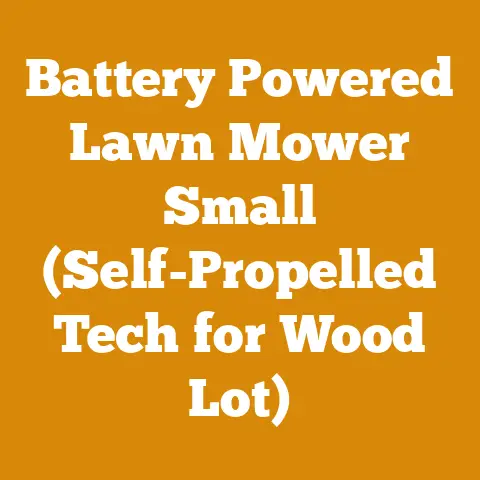Chiminea Stove Benefits (5 Smoke Control Tips Every Arborist Needs)
Introduction: The Arborist’s Evening – Beyond the Chainsaw’s Roar
The day is done. The echoes of the chainsaw, the satisfying thud of falling timber, and the scent of fresh-cut wood cling to my clothes. As an arborist, I know the hard work that goes into tree care and wood processing. But after a long day wrestling with branches and logs, there’s nothing quite like the simple pleasure of relaxing by a warm fire. For years, I relied on open fire pits, but the smoke always seemed to find me, no matter where I sat. Then, I discovered the chiminea stove. It was a game-changer. Not only did it provide a more focused and efficient heat source, but it also significantly reduced the amount of smoke swirling around, a crucial consideration, especially if you’re trying to respect your neighbors or comply with local air quality regulations.
Key Takeaways: Smoke Less, Enjoy More
Before we dive in, here’s what you’ll learn:
- Reduced Smoke: Chiminea stoves are designed to minimize smoke output compared to open fires.
- Efficient Heat: They provide more directional and concentrated heat.
- Fuel Efficiency: Often, they burn wood more efficiently, requiring less fuel.
- Aesthetic Appeal: They add a touch of rustic charm to any outdoor space.
- Practical Smoke Control Tips: Five actionable strategies to further reduce smoke from your chiminea.
Chiminea Stoves: A Brief Overview
Chiminea stoves, originating in Mexico, are freestanding, front-loading fireplaces with a bulbous body and a vertical chimney or stack. Traditionally made from clay, modern versions also come in cast iron, steel, and other materials. Their design is what sets them apart, particularly regarding smoke control.
Why Choose a Chiminea Stove? The Arborist’s Perspective
As someone constantly dealing with wood, I appreciate tools that are both functional and efficient. Here’s why I think a chiminea stove is a great choice:
- Smoke Reduction: This is the big one. The chimney directs smoke upwards, away from your seating area. This is especially important if you have neighbors close by or live in an area with strict air quality regulations. I remember one summer when I was burning wood in an open pit and received a friendly (but firm) reminder from my neighbor about the smoke. That’s when I started looking for alternatives.
- Efficient Heat: The enclosed design allows the chiminea to radiate heat more effectively. You get more warmth with less wood. This is particularly useful on those chilly evenings after a long day of tree trimming.
- Safety: The enclosed fire is generally safer than an open fire pit, reducing the risk of stray embers sparking a fire.
- Aesthetic Appeal: Let’s be honest, chimineas look great! They add a touch of rustic charm to any patio or backyard.
- Versatility: They can burn various types of wood, although certain woods are better suited than others (more on that later).
The Smoke Problem: Why It Matters
Smoke isn’t just a nuisance; it’s a health hazard. Wood smoke contains fine particulate matter (PM2.5), which can irritate the lungs, worsen respiratory conditions, and even contribute to heart problems. According to the EPA, exposure to wood smoke can be especially harmful to children, the elderly, and people with existing respiratory issues.
Moreover, smoke can be a major source of air pollution in residential areas. Many municipalities have regulations regarding open burning, and excessive smoke can lead to fines or other penalties. As arborists, we are stewards of the environment and should be mindful of our impact.
5 Smoke Control Tips Every Arborist Needs
Now, let’s get to the heart of the matter: how to minimize smoke from your chiminea stove. These tips are based on my personal experience, research, and conversations with other wood-burning enthusiasts.
1. Season Your Wood Properly: The Key to Clean Burning
- The Importance of Dry Wood: This is, without a doubt, the most crucial factor in reducing smoke. Wet or green wood contains a high percentage of moisture, which must be boiled off before the wood can burn efficiently. This process creates a lot of smoke.
- How to Season Wood:
- Split the Wood: Splitting wood increases the surface area exposed to air, accelerating the drying process.
- Stack it Properly: Stack the wood in a single row, elevated off the ground on pallets or sleepers. This allows air to circulate freely. Leave space between the rows.
- Cover the Top: Protect the wood from rain and snow by covering the top of the stack with a tarp or roof. Leave the sides open for ventilation.
- Be Patient: Seasoning wood takes time. Generally, hardwood like oak or maple needs at least six months to a year to dry properly. Softwood like pine may dry faster.
- Measuring Moisture Content: Invest in a moisture meter. The ideal moisture content for firewood is below 20%. I use a simple pin-type meter that gives me a quick and accurate reading. It’s a worthwhile investment.
- Personal Story: I once made the mistake of burning wood that I thought was dry. The result was a smoky, smoldering mess that barely produced any heat. It was a frustrating experience and taught me the importance of proper seasoning.
- Data Point: Studies show that burning properly seasoned wood can reduce smoke emissions by up to 70% compared to burning green wood.
2. Choose the Right Wood Species: Not All Wood is Created Equal
- Hardwoods vs. Softwoods: Hardwoods like oak, maple, ash, and birch are generally better for burning in a chiminea than softwoods like pine, fir, and spruce. Hardwoods are denser, burn longer, and produce less smoke.
- Resin Content: Softwoods contain more resin, which contributes to increased smoke and creosote buildup in the chimney. Creosote is a flammable substance that can pose a fire hazard.
- Ideal Wood Choices:
- Oak: A classic choice. It burns hot and long, with minimal smoke when properly seasoned.
- Maple: Another excellent option. It’s relatively easy to split and seasons well.
- Ash: Known for its low moisture content even when green, ash dries quickly and burns cleanly.
- Birch: Produces a pleasant aroma and burns well, but can be prone to sparking.
- Wood to Avoid:
- Green Wood: As mentioned earlier, avoid burning unseasoned wood of any species.
- Treated Wood: Never burn treated wood, as it releases toxic chemicals into the air.
- Painted Wood: Similar to treated wood, painted wood can release harmful fumes.
- Driftwood: Salt-soaked driftwood can be difficult to burn and may release corrosive chemicals.
- Local Considerations: The best wood to burn often depends on what’s readily available in your area. Talk to local firewood suppliers to find out what species are most common and well-suited for burning.
- Expert Quote: “The type of wood you burn has a significant impact on smoke emissions,” says Dr. Emily Carter, a forestry researcher at the University of Maine. “Hardwoods, when properly seasoned, are the cleanest and most efficient choice.”
3. Master the Art of Fire Building: The Top-Down Approach
- Traditional Fire Building: The traditional method of building a fire involves starting with tinder, adding kindling, and then gradually introducing larger pieces of wood. While this method works, it can often produce a lot of smoke, especially in the initial stages.
- The Top-Down Method: This method involves placing the largest pieces of wood at the bottom of the fire pit, followed by layers of kindling and tinder on top. The fire burns downwards, gradually igniting the larger pieces of wood.
- Benefits of the Top-Down Method:
- Reduced Smoke: By igniting the fire from the top, the smoke and gases released from the wood pass through the flames, burning more completely and reducing emissions.
- More Efficient Burning: The fire burns more evenly and consistently.
- Less Maintenance: You don’t need to constantly add wood to the fire.
- Step-by-Step Instructions:
- Place the Largest Pieces: Arrange several large pieces of seasoned wood at the bottom of the chiminea.
- Add Kindling: Place a layer of kindling on top of the large pieces of wood, arranged in a crisscross pattern.
- Add Tinder: Place a small amount of tinder (e.g., dry leaves, twigs, or commercial fire starters) on top of the kindling.
- Light the Tinder: Ignite the tinder with a match or lighter.
- Let it Burn: Allow the fire to burn downwards, gradually igniting the kindling and then the larger pieces of wood.
- Personal Anecdote: I was skeptical about the top-down method at first, but after trying it a few times, I was amazed at how much less smoke it produced. It’s now my go-to method for building fires in my chiminea.
4. Maintain Proper Airflow: Let the Fire Breathe
- The Importance of Air: Fire needs oxygen to burn efficiently. Without adequate airflow, the fire will smolder and produce a lot of smoke.
- Chiminea Design and Airflow: Chimineas are designed to promote airflow through the fire chamber and up the chimney. However, it’s important to ensure that the air vents are not blocked by ash or debris.
- Tips for Maximizing Airflow:
- Clean the Ash Regularly: Ash buildup can restrict airflow. Remove ash from the fire chamber regularly, using a shovel or ash vacuum.
- Elevate the Wood: Place the wood on a grate or fire ring to allow air to circulate underneath.
- Adjust the Damper (if applicable): Some chimineas have a damper in the chimney that can be adjusted to control airflow. Experiment with different settings to find the optimal balance.
- Avoid Overloading the Fire Chamber: Don’t cram too much wood into the chiminea, as this can restrict airflow.
- Troubleshooting Smoke Issues: If you’re experiencing excessive smoke, check the airflow. Make sure the ash is cleared, the wood is elevated, and the damper (if present) is properly adjusted.
- Data Point: Studies have shown that increasing airflow to a wood fire can reduce smoke emissions by up to 50%.
5. Regular Chimney Maintenance: Keep it Clean, Keep it Safe
- Creosote Buildup: As mentioned earlier, creosote is a flammable substance that accumulates in the chimney as a result of burning wood. Creosote buildup can pose a significant fire hazard.
- The Importance of Regular Cleaning: It’s essential to clean your chiminea chimney regularly to remove creosote and prevent chimney fires.
- How Often to Clean: The frequency of cleaning depends on how often you use your chiminea and the type of wood you burn. As a general rule, it’s a good idea to inspect the chimney every few months and clean it at least once a year.
- Cleaning Methods:
- Chimney Brush: The most common method of cleaning a chimney is to use a chimney brush. These brushes come in various sizes and shapes to fit different chimney diameters.
- Chimney Sweep: For more thorough cleaning, you can hire a professional chimney sweep. They have specialized equipment and expertise to remove creosote and other debris from the chimney.
- Safety Precautions:
- Wear Protective Gear: When cleaning a chimney, wear gloves, safety glasses, and a dust mask to protect yourself from creosote and other debris.
- Work in a Well-Ventilated Area: Clean the chimney outdoors or in a well-ventilated area to avoid inhaling dust and fumes.
- Dispose of Creosote Properly: Creosote is flammable and should be disposed of properly. Contact your local waste management authority for guidance.
- Personal Experience: I learned the importance of chimney maintenance the hard way. I neglected to clean my chiminea for a couple of years, and when I finally did, I was shocked at how much creosote had accumulated. It was a wake-up call, and now I make sure to clean my chimney regularly.
Beyond the Basics: Advanced Smoke Control Techniques
For those who are serious about minimizing smoke, here are a few more advanced techniques:
- Catalytic Combustors: Some high-end wood stoves and fireplaces are equipped with catalytic combustors, which are devices that burn off smoke and gases at a lower temperature. While chimineas typically don’t have catalytic combustors, it’s worth knowing about this technology.
- Forced-Air Systems: Some outdoor fireplaces use forced-air systems to improve combustion and reduce smoke. These systems typically involve a fan that blows air into the fire chamber, increasing oxygen levels.
- Alternative Fuels: Consider using alternative fuels like wood pellets or compressed wood logs. These fuels are often drier and burn more cleanly than traditional firewood. However, make sure your chiminea is designed to burn these types of fuels.
- Experimentation: Don’t be afraid to experiment with different wood species, fire-building methods, and airflow adjustments to find what works best for your chiminea and your local conditions.
Addressing Common Concerns
- Chiminea Cracking: Clay chimineas are prone to cracking, especially if exposed to extreme temperature changes. To prevent cracking, cure the chiminea properly before first use, avoid burning excessively large fires, and protect it from the elements when not in use.
- Rusting: Cast iron and steel chimineas can rust over time. To prevent rusting, apply a heat-resistant paint or sealant regularly.
- Smoke Smell on Clothes: Burning wood can leave a smoky smell on your clothes. To minimize this, wear older clothes when tending the fire and avoid standing directly in the smoke plume.
The Future of Wood Burning: Sustainability and Innovation
As environmental awareness grows, there’s increasing pressure to reduce emissions from wood burning. Manufacturers are developing cleaner-burning wood stoves and fireplaces, and researchers are exploring new technologies to improve combustion efficiency. As arborists, we can play a role in promoting sustainable wood burning practices by choosing responsibly sourced wood, seasoning it properly, and using efficient burning techniques.
Conclusion: A Smarter, Cleaner Fire
Investing in a chiminea stove and implementing these smoke control tips can significantly enhance your outdoor fire experience. By choosing the right wood, building your fire strategically, maintaining proper airflow, and keeping your chimney clean, you can enjoy the warmth and ambiance of a wood fire without the excessive smoke.
Remember, responsible wood burning is not only better for your health and your neighbors but also for the environment. As arborists, we have a responsibility to promote sustainable practices and minimize our impact on the world around us. So, go ahead, light that fire, and enjoy a smoke-free evening under the stars.
Next Steps:
- Assess Your Needs: Determine the size and type of chiminea stove that best suits your needs and budget.
- Source Seasoned Wood: Find a reliable supplier of seasoned firewood in your area.
- Invest in Tools: Purchase a moisture meter, chimney brush, and other essential tools.
- Practice Smoke Control Techniques: Experiment with different fire-building methods and airflow adjustments.
- Enjoy! Relax and enjoy the warmth and ambiance of your chiminea stove.
Call to Action:
Ready to upgrade your outdoor fire experience? Check out your local hardware store or online retailers for a wide selection of chiminea stoves and accessories. And don’t forget to share your own smoke control tips in the comments below! Happy burning!






